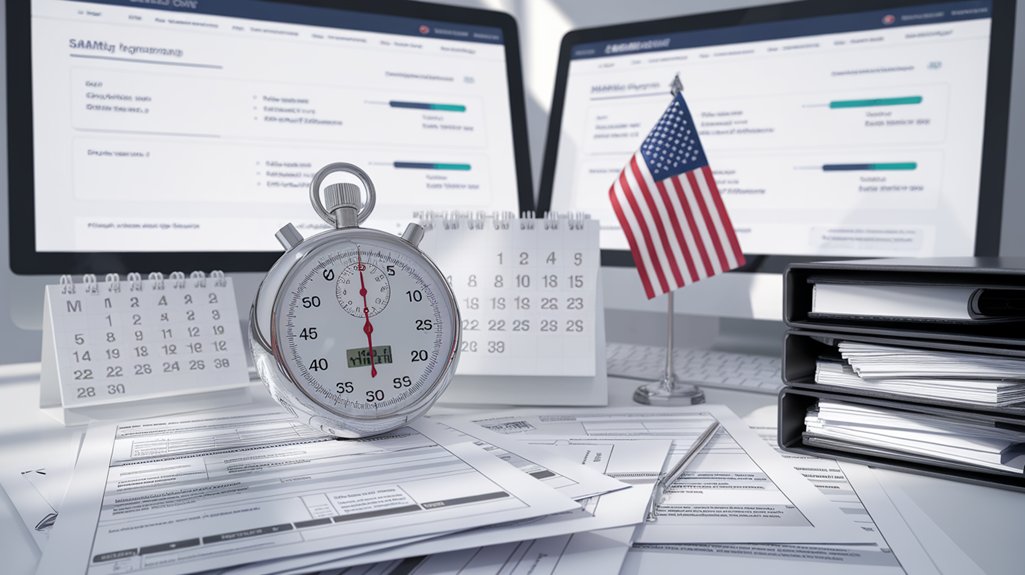SAM registration typically takes 2-8 weeks to complete fully. The initial submission requires about 45 minutes, followed by multiple verification processes with federal databases. Factors extending timelines include errors in submitted information, incomplete documentation, complex business structures, and delayed notarized letter submissions. International registrations face additional hurdles, requiring NCAGE codes and special verification steps. Organizations can expedite the process by preparing documentation in advance and ensuring accuracy of all submitted information. Further exploration reveals strategies to navigate common registration roadblocks.
Table of Contents
ToggleUnderstanding the SAM Registration Timeline

When businesses decide to work with the federal government, understanding the SAM registration timeline becomes critical for proper planning. The complete registration process typically spans 2 to 8 weeks, though some straightforward applications may be activated sooner.
The initial submission through SAM.gov takes approximately 45 minutes to complete, but this represents only the beginning of the process. Once submitted, the system verifies information against federal databases, including IRS validation of tax identification numbers. Since April 2022, a Unique Entity Identifier is now assigned during the registration process. Obtaining a DUNS number beforehand is an essential preparatory step that typically requires 1-2 business days.
While completing the SAM.gov form takes just 45 minutes, your application then undergoes extensive federal database verification, including IRS tax ID validation.
Account activation generally occurs within 7-10 business days after submission, assuming all application requirements are met.
Several factors can extend these timeframes:
- Errors in submitted information
- Incomplete documentation
- Complex business structures requiring additional verification
- Delays in submitting required notarized letters
- Technical issues with the SAM.gov portal
Preparation is essential—collecting necessary documentation before beginning the registration will help minimize potential delays. First-time registrants should ensure complete accuracy when submitting information to avoid unnecessary processing delays and additional verification requirements.
Factors That Affect SAM Registration Processing

Several critical factors can greatly impact the timeline of a SAM registration process, extending it well beyond the standard processing period.
Entity validation issues often cause significant delays, particularly when business names or addresses don’t match IRS records, potentially adding 5-15 business days to processing times.
For organizations registering from abroad, international considerations present additional challenges:
- NCAGE code applications for foreign entities typically require 15-30 business days
- Foreign entity validation may add 10-20 business days to the timeline
- Verification of international banking details can extend processing by 5-15 days
Complex organizational structures further complicate registration.
Parent-child relationships require 7-14 additional days for verification, while joint ventures may extend timelines by 15-25 business days.
Technical issues, such as Login.gov authentication problems, can also delay the process by 3-7 business days.
Incomplete or missing Points of Contact information can result in registration removal after the 90-day work in progress period expires.
Regulatory changes may create additional compliance requirements that can extend processing times unexpectedly.
Many organizations choose to work with professional registration services to navigate these complexities and increase their first-time success rate.
Strategies to Accelerate Your SAM Registration

Businesses seeking government contracts can greatly reduce their SAM registration timelines through strategic preparation and execution. Implementing proper document readiness before beginning the registration process notably impacts overall efficiency.
Pre-registration research proves essential, as understanding requirements prevents time-consuming errors during submission. Companies should collect all necessary documentation, including DUNS numbers and TINs, before starting the online process. Batching information in advance allows for smoother form completion. Promptly responding to requests from verification processes can significantly reduce delays in your application review.
Registration efficiency improves when businesses:
- Allocate dedicated time for completing forms without interruption
- Verify key information against official records
- Organize digital filing systems for quick document retrieval
- Consider professional assistance for complex registrations
Maintaining accurate NAICS codes and thorough business descriptions enhances both compliance and visibility. Selecting relevant NAICS codes aligned with your business capabilities significantly improves your chances of winning federal contracts. Remember that annual renewal is mandatory as SAM registration requires updates every 12 months to maintain eligibility for federal opportunities.
Companies that implement streamlined navigation techniques through SAM.gov’s interface typically experience faster validation and fewer errors requiring correction.
Frequently Asked Questions
Can Foreign Entities Register in SAM.Gov?
Foreign entities are eligible to register in SAM.gov, following specific registration process requirements established for international organizations.
The process includes creating a Login.gov account, obtaining a UEI during registration, and providing precise legal entity details.
Foreign registrations typically process in about 14 business days but may take up to 45 business days.
Entities must maintain annual updates to keep their registration active, allowing them to participate in U.S. government contracting opportunities.
Is SAM Registration Free or Are There Any Fees Involved?
SAM registration is completely free, with no official government fees for standard entity registration or renewal.
The SAM registration cost structure remains at zero for obtaining a UEI, accessing federal opportunities, and using status tracking tools.
However, businesses should be aware of potential expenses when using third-party services, which typically charge $500-$2,500+ for assistance.
Additional hidden costs may include notarization fees ($5-$25) and identity verification expenses.
What Happens if My SAM Registration Expires?
When a SAM registration expires, several significant registration consequences occur.
Businesses lose eligibility for federal contracts, become invisible in the SAM database, and may experience payment delays for existing contracts.
The renewal process should begin 60-90 days before expiration to avoid disruptions.
During renewal, companies must update and validate all information for accuracy.
Failing to renew on time can result in missed contract opportunities and potential removal from current government projects.
Can I Apply for Federal Contracts During SAM Registration Processing?
Businesses cannot apply for federal contracts during the SAM application process.
Federal contracts eligibility requires an active SAM registration, which is only obtained after complete processing. While waiting for approval, organizations should prepare other necessary documentation and research potential opportunities.
The federal government strictly requires active status before awarding any contracts or grants. Companies should plan their timelines accordingly, allowing for the 2-8 week processing period before pursuing contract applications.
Is a DUNS Number Still Required for SAM Registration?
No, a DUNS number is no longer required for SAM registration.
Since April 2022, the federal government has replaced DUNS with the Unique Entity ID (UEI) system.
When examining DUNS number requirements today, businesses will find that UEI serves as the primary DUNS number alternative.
The UEI is automatically generated during the SAM.gov registration process, eliminating the previous step of obtaining a DUNS number from Dun & Bradstreet before registration.